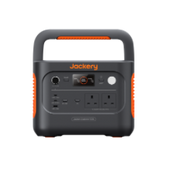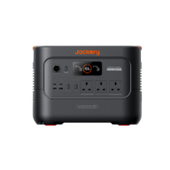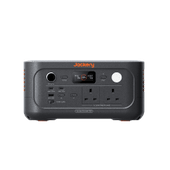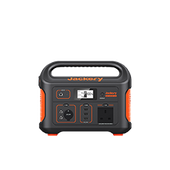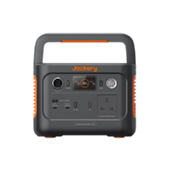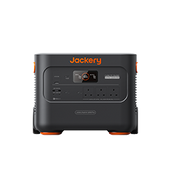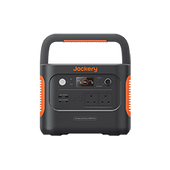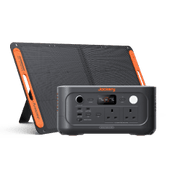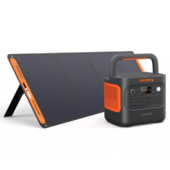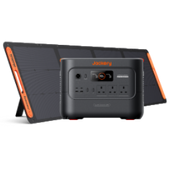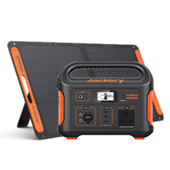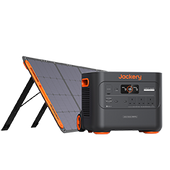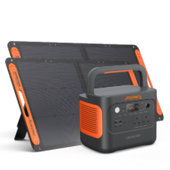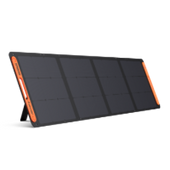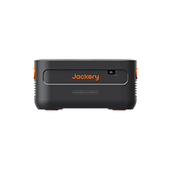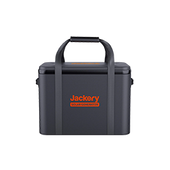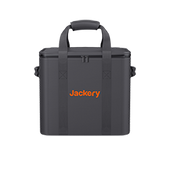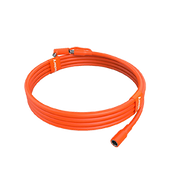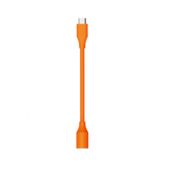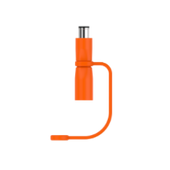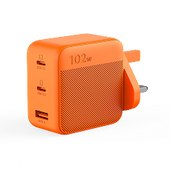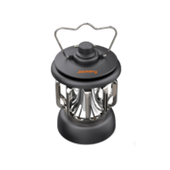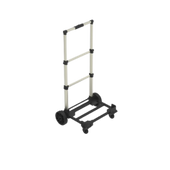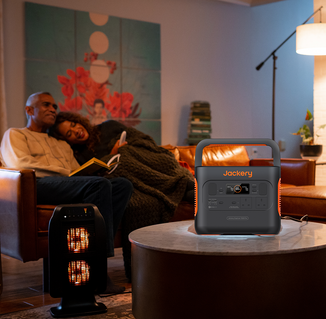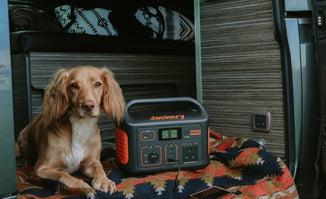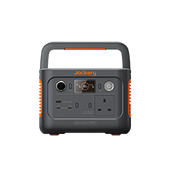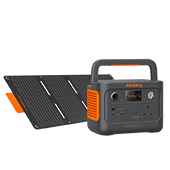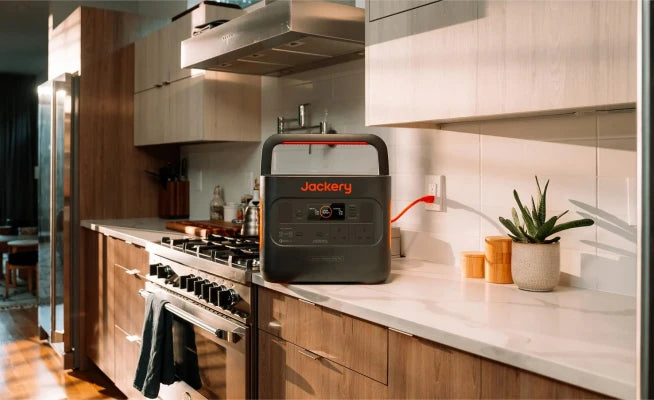A 3kWh battery is a battery system with a storage capacity of 3kWh. Theoretically, it can discharge continuously for 1 hour at a power of 3kW or for 3 hours at a power of 1kW. However, 3 kWh batteries have a small capacity and average economic performance. They are suitable for specific low-demand scenarios such as small and medium-sized energy storage, backup power, or mobile energy.
This blog explores the working principle, application scenarios, operating time, cost, and how to choose the best 3kWh battery. Furthermore, we strongly recommend Jackery Explorer 2000 Plus and 3000 v2, the best 3000W portable power station for home backup, outdoor activities, and professional use.
|
Key Takeaways: |
|
- A 3kWh battery is an energy storage system that works in three steps: energy generation, storage and use. - In theory, a 3kWh battery can power a 1kW device for about 3 hours. - A 3kWh battery is suitable for various scenarios with low power demand, such as camping or RV power, electric bicycle batteries or emergency backup power. - A 3 kWh battery is usually insufficient for an average British household. - The price of a 3kWh battery in the UK ranges from £2,500 to £3,500. - The best 3kWh battery must have UKCA certification, a 10-year warranty, and smart features like APP remote monitoring. |
How Does a 3kWh Battery Work?
3kWh battery is an energy storage system, and its working principle involves three steps: energy generation, storage and use. The following is a detailed analysis of the working principle of a 3 kWh battery:
Energy Generation
The power of a 3kWh battery usually comes from external sources, such as the power grid (home/industrial electricity), renewable energy (solar panels, wind turbines), or other power generation equipment (diesel generators, etc.).
For example, the core of a 3kWh lithium-ion battery converts chemical energy into electrical energy, which can be summarised as "ion shuttle power generation." During charging, the external power source drives lithium ions to "deintercalate" from the positive electrode through the electrolyte to embed into the negative electrode. At the same time, electrons flow to the negative electrode through the external circuit to form a current.
Energy Storage
The electrical energy generated by charging with an external power source is stored in the battery. The maximum capacity of a 3kWh battery is undoubtedly 3kWh, which can continuously power a 3kW device for 1 hour.
However, batteries usually have self-discharge; they slowly lose power when stationary. Today's batteries can control their self-discharge rate at an extremely low level (such as <1% per month) by optimising materials and BMS algorithms.
Energy Use
When the 3kWh battery is connected to an electrical device, the BMS will adjust the current output according to demand. If it is a DC load (such as LED lights or electric vehicles), it can be used directly or adjusted through a DC-DC converter. If a household appliance or industrial equipment needs alternating current (AC), the 3kWh battery must use an inverter to invert the current.
For example, during the discharge process of a 3kWh lithium-ion battery, lithium ions return from the negative electrode to the positive electrode, and electrons flow again to power the device.

How Long Can a 3kWh Battery Last?
A 3kWh battery can power a 1kW device for about 3 hours or a 0.1kW device for 30 hours. However, the actual usage time of a 3kWh battery usually depends on the connected device's power.
You can estimate the usage time of a 3 kWh battery by the following calculation formula:
Usage time of a 3 kWh battery (hours) = battery capacity (kWh) / device power (kW)
Example 1: If you run five 100W (0.1kW) light bulbs, a 3kWh battery can be used for 6 hours. (3kWh / (0.1kW*5) = 6 hours)
Example 2: If you run a 200W (0.2kW) laptop, a 3kWh battery can be used for 15 hours. (3kWh / 0.2 = 15 hours)
Example 3: If you run a 1500W (1.5kW) electric kettle, a 3kWh battery can be used for 2 hours. (3kWh /1.5=2 hours)
However, the above are the power supply durations of 3 kWh batteries under ideal conditions. Batteries lose power when charging and discharging (usually 80~90%), and the actual usage time may be shortened by 10~20%. Low temperatures can also significantly reduce battery performance.

Devices and Time that 3kWh Batteries Can Power
A 3kWh (3000Wh) battery can usually power various devices, including small electronic devices, household appliances, outdoor equipment, and power tools. However, the specific power supply time depends on the device's power.
Small Electronic Devices
The capacity of a 3kWh battery is suitable for powering various low-power small electronic devices to meet daily needs. For example, a 3kWh battery can charge a smartphone with an average power of 5W for 600 consecutive times (calculated based on 10Wh required for each full charge).
The following is the power and power supply time that a 3kWh battery can power small electronic devices (assuming the battery efficiency is 100%, there may be 10-20% loss in actual use):
|
Small Electronic Device |
Wattage |
Power Supply Time |
|
Smartphone |
5W |
600 times |
|
Laptop |
50W |
60 hours |
|
Wi-Fi router |
10W |
300 hours |
Household Appliances
A 3kWh battery can only power a few household appliances, such as TVs, fans, rice cookers, hair dryers, etc. However, it can continuously power a 40-inch LED TV with an average power of 50W for 60 hours.
The following is the time that a 3kWh battery can power household appliances (assuming the battery efficiency is 100%, there may be 10-20% loss in actual use):
|
Household Appliances |
Wattage |
Power Supply Time |
|
LED bulb |
10W |
300 hours |
|
TV (40-inch LED) |
50W |
60 hours |
|
Microwave/oven |
800-2000W |
3 hours-1.5 hours |
Outdoor Equipment
The 3kWh battery is an ideal choice for many people for outdoor camping, emergency power backup and off-road travel due to its portability and moderate capacity. Whether camping, lighting or powering entertainment equipment, the 3kWh battery can operate stably.
The following is the time that a 3kWh battery can power outdoor equipment (assuming the battery efficiency is 100%, there may be 10-20% loss in actual use):
|
Outdoor Equipment |
Wattage |
Power Supply Time |
|
Camping light |
5W |
600 hours |
|
Projector |
10-30W |
100-300 hours |
|
Portable refrigerator |
50W |
60 hours |
Power Tools
In outdoor operations, emergency power supply, and other scenarios, a 3kWh battery can power small power tools for several hours. However, large power tools may require a larger battery or a fuel generator combination. For example, a 3kWh battery can power a 500W handheld drill for 6 hours.
Here is how long a 3kWh battery can power a power tool (assuming the battery efficiency is 100%, there may be 10-20% loss in actual use):
|
Power Tools |
Wattage |
Power Supply Time |
|
Drill |
500W |
6 hours |
|
Lawn mower |
1000W |
3 hours |
Where Is a 3 kWh Battery Commonly Used?
The 3 kWh battery capacity belongs to a small energy storage system, which is suitable for various scenarios with low power demand. The following are typical application areas of 3 kWh batteries:
Outdoor Power
3kWh batteries can usually be used as camping or RV power sources for lighting, small appliances, and mobile devices. If the 3kWh battery is paired with a solar panel, off-grid power can be achieved to a certain extent.
Small Electric Vehicles
Usually, electric bicycles or motorcycles equipped with 3kWh batteries can support a range of 50-100 kilometres. In addition, 3kWh batteries are often used in electric scooters or low-speed electric vehicles to meet personal or short-distance travel needs.
Home Energy Storage System
Some families use 3kWh batteries (paired with home solar systems) as emergency backup power to power critical loads (such as lighting, refrigerators, and routers) during power outages. In addition, 3kWh batteries can also power gardening equipment, such as small electric lawnmowers, if you are doing intermittent work outdoors.
Microgrids
In areas or islands without electricity, 3 kWh batteries can form a small independent power supply system with renewable energy. As a small UPS, the 3kWh battery can protect short-term power outages for key equipment such as cash registers and servers.
In short, the 3kWh battery's flexibility and moderate capacity make it widely used in distributed energy, mobile electricity, and small and medium-sized energy storage. Compared with large-capacity batteries, the 3kWh battery is more suitable for individuals or small projects with limited budgets.

Is a 3kWh Battery Enough for an Average Household?
In the UK, whether a 3kWh battery is sufficient to meet the needs of an average household depends on the specific electricity usage, battery usage, and household size.
Electricity Usage of an Average Household in the UK
According to Ofgem data, a household's average daily electricity consumption in the UK is 7.4 kWh. If the heating demand is high in winter, it will likely exceed 10 kWh. These figures are much higher than 3 kWh. Therefore, the capacity of a 3kWh battery can only cover 30% to 40% of the average household's daily electricity consumption. If an average British household relies solely on a 3kwh battery, it won't be easy to meet daily needs.
Applicability of 3 kWh Batteries
It is difficult for a 3kWh battery to become the primary source of electricity for an average British household. It is only suitable for short-term backup power or an auxiliary role in "peak shaving and valley filling".
Short-term backup power: A 3 kWh battery can power some key equipment such as lighting, routers, and refrigerators for about 1-2 hours, but it cannot support long-term electricity consumption for the entire house.
With solar energy: If a household installs solar panels, a 3 kWh battery can store excess electricity when needed. However, the energy stored in a 3 kWh battery can usually only cover part of the demand (such as basic appliances) and needs to be supplemented by the grid.
Limitations of 3kWh Batteries
A 3kWh battery only accounts for 30%—40% of an average British household's daily electricity consumption and cannot independently support the demand throughout the day. The instantaneous power demand during peak hours (such as at night) may reach 2- 4 kW; a 3kwh battery cannot support long-term operation and will quickly exhaust its power.
If charging depends on renewable energy such as solar energy, rainy weather may further limit the practicality of a 3 kWh battery. Especially in winter, when the sunshine is reduced, it is difficult for a 3kWh battery to store enough electricity for nighttime use.
In short, a 3kWh battery is usually insufficient for an average British household and is only suitable for specific small-scale needs or as a supplementary system. For example, for a small family or a low-energy house, a 3 kWh battery is barely enough when combined with energy-saving appliances and solar energy.
Best 3000W Jackery Portable Power Station
A 3kWh battery allows you to store excess solar energy generated during the day rather than exporting it to the grid for a lower price. This stored energy can then be used in the evening or during periods of low sunlight, significantly increasing your self-consumption of renewable energy and reducing your reliance on grid electricity.
Portable power stations are another form of solar battery. Jackery has a wide range of selections for homeowners and outdoor enthusiasts. We recommend Jackery Explorer 2000 Plus and 3000 v2 for their higher capacity, portability, versatility, safety, and quiet operation.
Get ready to elevate your power game with our exclusive Early Bird Benefits! For a limited time, you can save up to £350 on your purchase and receive a free gift package valued at £327.99, which includes a car charging cable, an Extreme Guard Carrying Bag, and a trolley. Enjoy financial flexibility with a 3-month interest-free installment plan through PayPal, and rest easy knowing your investment is protected by a hassle-free 5-year warranty.
Jackery Explorer 2000 Plus
The Jackery Explorer 2000 Plus portable power station can power 99% of appliances with expandable capacity. Using five add-on Jackery Battery Pack 2000 Plus at a time, you can expand the capacity of the LiFePO4 battery from 2kWh to 12kWh. The solar generator also supports parallel operation by connecting two Explorer 2000 Plus.
|
Jackery Explorer 2000 Plus |
|
|
Capacity |
2042.8Wh |
|
Expandable Capacity |
Yes (2-12 kWh) |
|
Battery Cell |
LiFePO4 |
|
Weight |
27.9 kg |
|
Size |
47.3 x 35.94 x 37.36cm |
|
Recharge Life Cycle |
4000 cycles to 70%+ capacity |
|
APP Control |
Yes |
|
UPS |
20ms |
|
Working Temperature |
Charge Temperature: 0~45C Discharge Temperature:-10~45C |
|
Quiet Level |
Less than 30dB |
|
LED Light |
No |
|
Portability |
Pull Rods & Double Wheels |
Expandable Powerhouse: Featuring up to 2042.8Wh gigantic capacity, the Jackery Explorer 2000 Plus Power Station can power a range of heavy load devices, with up to 3000W capacity - including refrigerators, kettles, and more, satisfying all your power requirements. The Jackery Explorer 2000 Plus supports up to 5 expandable battery packs, featuring power expanded from 2k to 12kWh—voltage to 240V and output to 6000W, matching all your power requirements indoors and outdoors.
Fast Solar Charging: Charge directly from the sun or via a wall outlet conveniently, quickly, and worry-free. Connecting 6*SolarSaga 200W solar panels or connecting via a wall outlet takes 2 hours for the Explorer 2000 Plus to charge fully.
Safe Charging Experience: Adopting advanced Lithium Technology, the Jackery Explorer 2000 Plus is highly temperature resistant, ensuring cells operate efficiently and safely. The built-in cooling system further improves heat dissipation efficiency by 30% andprovides protection, including shock and fire resistance, providing a safe charging experience.
Longer Lifespan: Thanks to Jackery's innovative ChargeShield Fast Charging Technology, the Explorer 2000 Plus Power Station's battery life is boosted by 50%. A safe LiFePO4 battery that can last up to 10 years significantly extends battery lifespan.
Smart App Control: Easily manage your Explorer 2000 Plus using Wi-Fi or Bluetooth. It's now easier than ever to monitor remaining battery levels and use the other App functions. Multiple advanced settings can be customised to meet individual requirements, ensuring round-the-clock energy control.
Shock-Resistance Design: Jackery AI variable-speed charging solution intelligently optimises power. Dual physical protections with 62 mechanisms enhance safety for every energy use. UL 94 V-0 flame retardant, UL fall protection, and grade-9 shock-resistant design ensure comprehensive safety.

What Can a Jackery Explorer 2000 Plus Run?
Due to its expandable power capacity, the Explorer 2000 Plus is perfect for long-term outings or power outages. It can power low-to-high appliances, including ovens, refrigerators, microwaves, water pumps, etc.
Home Backup: In brief or long-term power outages, the Jackery Explorer 2000 Plus Portable Power Station can ensure essential household appliances remain powered and functional. For example, it can charge the refrigerator to keep food and medicine fresh, a CPAP machine for an uninterrupted and peaceful night's sleep, and even TVs to provide entertainment.
Camping or Other Long-Term Outdoor Activities: The Explorer 2000 Plus is expandable and can support long-term outings. If you plan an outdoor adventure in a remote location, consider the Jackery Explorer 2000 Plus Portable Power Station. It can help run a portable freezer to keep food fresh, camper or RV lights illuminating the outdoor space at night, or an outdoor grill for outdoor cooking.
Outdoor Work: If you often work remotely from a scenic location or are building a pergola in your home's backyard, the Jackery Explorer 2000 Plus Portable Power Station has you covered. It can supply stable electricity to cordless drills or other power tools to complete any repair or construction tasks outdoors without a power supply.
|
Running Time of Jackery Solar Generator 2000 Plus |
|
|
Appliances |
Running Time |
|
For Home Backup |
|
|
TV (60W) |
27.2-160H |
|
Refrigerator (400W) |
4.1-24H |
|
Coffee Maker (550W) |
3-17.5H |
|
Oven (850W) |
1.9-11.3H |
|
Ceiling Fan (200W) |
8.2-48H |
|
For Camping or Other Outdoor Activities |
|
|
Camping Stove (1500W) |
1.1-6.4H |
|
Portable Cooler (200W) |
8.2-48H |
|
Kettle (1600W) |
1.1-6H |
|
Blender (300W) |
5.3-32H |
|
Camping Light (5W) |
72.8-1920H |
|
For Outdoor Work |
|
|
Lawn Mower (2200W) |
0.8-4.4H |
|
Band Saw (800W) |
2.1-12H |
|
Chainsaw (1200W) |
1.4-8H |
|
Angle Grinder (500W) |
3.4-19.2H |
|
Power Tool (900W) |
1.9-10.7H |
(*The working hours are only for reference; the actual working hours depend on your usage.)
What Do Jackery Users Think about the Jackery Explorer 2000 Plus?
I'm not technically savvy, but I understand a few things. It's hurricane season, and we had freaky snowstorms in October! Leaving in the Northeast, one never knows, so I bought this generator. It arrived quickly. My husband charged it, and it was ready to go. I feel better having backup power when unexpected lousy weather conditions come. I compared generators out there. This one won me over.
Jackery Explorer 3000 v2
The Jackery Explorer 3000 v2 is a high-capacity portable power station designed for reliable and versatile energy on the go, perfect for RV trips, outdoor adventures, and essential home backup. Boasting a large 3072Wh LiFePO4 battery and a robust 3600W AC output (with a 7200W surge), it can power a wide range of appliances, from refrigerators to power tools.
|
Jackery Explorer 3000 v2 |
|
|
Capacity |
60Ah/51.2V DC (3072 Wh) |
|
AC Output |
3600W AC output, 7200W surge |
|
Battery Cell |
LiFePO4 |
|
Weight |
27 kg |
|
Size |
41.6×32.5×30.5cm |
|
Recharge Life Cycle |
4000 cycles to 70%+ capacity |
|
APP Control |
Yes |
|
UPS |
20ms |
|
Working Temperature |
Charge Temperature: 0~45C Discharge Temperature:-15~45C |
|
Quiet Level |
Less than 27dB |
|
Safety |
ChargeSheild 2.0, Jackery's ZeroDrain |
|
Portability |
Handle, Weather-Resistant Protection Bag |
Portable Powerhouse: With a 3072Wh capacity, 3600W continuous, and 7200W surge power, the Jackery 3000 v2 can handle more power-hungry appliances, such as air conditioners, microwaves, water pumps, and even some electric grills, ensuring they run smoothly. Its high output and capacity make it suitable for a vast majority of home devices, offering true versatility.
Smallest and Lightest 3kWh LFP Power Station: Despite its increased capacity and power, the 3000 v2 is lighter and more compact. Weighing approximately 59.5 lbs (27 kg), it's designed with integrated wheels and a handle for easy transport, making it highly portable for its power class. It is the world's lightest and smallest 3 kWh product, 47% smaller in size and 43% lighter in weight than mainstream products in the industry.
LiFePO4 Battery Technology: The 3000 v2 boasts 4000+ cycles to 70% capacity, meaning it can be fully charged and discharged thousands of times before its capacity significantly degrades. This translates to a lifespan of up to 10 years of daily use. LiFePO4 batteries are inherently more stable and less prone to thermal runaway, making them safer for indoor and outdoor use.
Uninterruptible Power Supply (UPS) Function: With an ultra-fast switching time of less than 20ms, the UPS feature provides seamless backup power during sudden outages. This is critical for sensitive electronics, such as computers, medical equipment (including CPAP machines), and routers, preventing data loss or interruptions.

What Can a Jackery Explorer 3000 v2 Run?
In the event of a power outage, the Jackery 3000 v2 transforms into a crucial lifeline capable of keeping your essential home appliances running. With its substantial 3072Wh capacity and robust 3600W continuous output, it can power critical devices for extended periods. This includes maintaining your refrigerator and ensuring the safety of your food.
For those embracing life on the road or enjoying extended camping trips, the Jackery 3000 v2 provides the comfort and convenience of home power. Its dedicated 30A (NEMA TT-30) RV outlet makes it a perfect companion for powering a wide range of RV appliances.
The powerful output and high capacity of the Jackery 3000 v2 make it an indispensable tool for outdoor work sites, DIY projects, and mobile businesses where grid power is unavailable. It can easily power a wide range of corded power tools.
|
Running Time of Jackery Explorer 3000 v2 |
|
|
TV (60W) |
31.8H |
|
Refrigerator (400W) |
6.2H |
|
Ceiling Fan (200W) |
11.8H |
|
Camping Stove (1500W) |
1.7H |
|
Portable Cooler (200W) |
11.8H |
|
Camping Light (5W) |
96.7H |
|
Lawn Mower (2200W) |
1.2H |
|
Power Tool (900W) |
2.8H |
(*The working hours are only for reference; the actual working hours depend on your usage.)
How to Choose the Best 3kWh Battery?
When choosing the best 3kWh battery in the UK, consider the following key factors to ensure safety, performance, long-term value and user experience.

Safety Certification and Compliance
Generally, 3kWh batteries must comply with the international energy storage battery safety standard (IEC 62619), focusing on thermal runaway and fire protection. In the UK, please give priority to UKCA-certified 3kWh batteries.
If you want to use the 3kWh battery with a solar system, it must meet the UK Microgeneration Product Certification Scheme (MCS) requirements.
Key Performance Parameters
The following are the key performance parameters you need to pay attention to when choosing a 3kWh battery:
Cycle Life: The nominal number of cycles of a 3kWh battery means the cycle life (number of charges and discharges). For example, a flooded battery usually lasts 300 to 700 cycles daily.
Charge and Discharge Efficiency: Generally, a high-efficiency 3kWh battery (≥90%) can reduce energy loss and increase the system's net output.
Self-Discharge Rate (%/month): The self-discharge rate measures the energy loss of a 3kWh battery when it is stationary. For example, a 3kWh battery with a low self-discharge rate (<3%/month) can improve long-term energy storage reliability.
Compatibility: If it is to be used with a solar system, the 3kWh battery must be matched with an existing solar or hybrid inverter.
Operating Temperature Range: The 3kWh battery can usually work in a temperature range of -20℃ to 55℃, avoiding low-temperature capacity attenuation or high-temperature safety risks.
Brand and Warranty Service
Due to different design and manufacturing processes, the final products developed by many other battery manufacturers are also different. For example, Tesla has a more substantial brand effect but a higher price. The British local brand GivEnergy is adaptable and has a friendly warranty policy.
Whatever brand you choose, try to choose a battery with the longest warranty period. A good battery has at least a 10-year warranty and covers capacity decay (such as maintaining 80% capacity after 10 years). You must also consider whether the after-sales service includes labour and parts replacement costs.
How Much Does a 3kWh Battery Cost in the UK?
When discussing the price of batteries in the UK market, it is necessary to consider the battery technology type (such as lead-acid or lithium-ion), brand, application scenario, and supply chain factors. A 1 kWh battery in the UK can be as low as around £200. And the price of a battery with a capacity of more than 12kWh can be as high as more than £10,000.
The price of a 3kWh battery in the UK ranges from £2,500 to £3,500, depending on the battery's chemistry, lifespan and storage capacity. (Data Source: Greenmatch)
Factors Affecting the Price of a 3kWh Battery
Please note that the 3kWh battery prices mentioned above are averages. The price you pay for a 3kWh battery will vary depending on the following factors:
Battery Type: Generally, lithium-ion batteries are more expensive than lead-acid batteries.
Brand: Tesla's batteries are more expensive than most UK domestic brands.
Installation Cost: The labour cost of a regular MCS installer is slightly more expensive.
Battery Management System (BMS) Complexity: Batteries with BMS systems with integrated intelligent monitoring (such as battery health status estimation and dynamic balancing management) are more expensive.
Are There Any Grants for Buying a 3kWh Battery?
While the cost of a battery may not be affordable, you can still find some ways to save money. For most people in the UK, the main way to reduce the cost of a 3kWh battery is to take advantage of VAT relief.
All households in England, Scotland and Wales will enjoy 0% VAT on solar batteries from April 1, 2022, to March 31, 2027. Green energy products purchased on or after April 1, 2027, will no longer enjoy 0% VAT but will be subject to 5% VAT. If you buy a 3kWh battery now, you can save between £1,500 and £2,300 (average £1,900). (Data Source: Greenmatch)
For example, buying a battery with an RRP of £5,000 could save £833.33 and only pay £4,166.67. In short, 0% VAT can save you around 20% on the cost of your battery. If you use a qualified MCS installer, the staff will apply for 0% VAT relief on your behalf and take care of everything.
3kWh Batteries FAQs
The following are the frequently asked questions about the 3kWh batteries in the UK.
1. How big is a 3kWh battery?
A 3kWh battery has a capacity of 3kWh, which can power a 3kW device for 1 hour.
The physical size of a 3kWh battery varies depending on the battery type, design, and manufacturer. For example, the volume of a Tesla Powerwall (13.5 kWh) is about 100L. By proportional conversion, we can know that the volume of a 3kWh battery is about 22L (including the shell and heat dissipation structure).
2. How long will a 3kW battery last?
The service life of a 3kWh battery depends on the device's power consumption. The following formula can calculate the approximate service life of a 3 kWh battery.
Service life (hours) = Battery capacity (kWh) ÷ Device power (kW)
For example, without considering the loss of charging efficiency, a 3kWh battery can charge a 5W smartphone about 600 times (3kWh ÷ 0.005kWh/time = 600 times).
3. How long does a 3kWh battery usually last?
Generally speaking, most modern 3kWh batteries have a service life of 10 to 15 years. However, the specific service life of a 3 kWh battery depends on its quality and how it is used and maintained.
4. Is a 3kWh battery good?
Whether a 3kWh battery is good depends on your specific needs and usage scenarios.
A 3kWh battery can last from a few hours to a day if it is used to power low-power devices such as routers, LED lights, fans, etc.
However, a 3kWh battery cannot support high-power appliances (such as air conditioners and electric water heaters), and the continuous power supply time is limited.
In short, if it is a low-power, short-term demand, or as a storage unit for renewable energy, then a 3kWh battery is a good choice.
Final Thoughts
In brief, the 3kWh battery cannot cover the normal British household's all-weather electricity needs and is better suited to low to medium-power demand scenarios, such as partial domestic electricity consumption, short-distance trips, or power provision for small gadgets. However, it cannot support the long-term operation of energy-intensive appliances like air conditioners.
If you require an efficient energy storage system or have a higher power demand, select a larger capacity battery depending on your real power consumption, budget, and installation conditions, and incorporate comprehensive solutions such as photovoltaics and intelligent power management.



